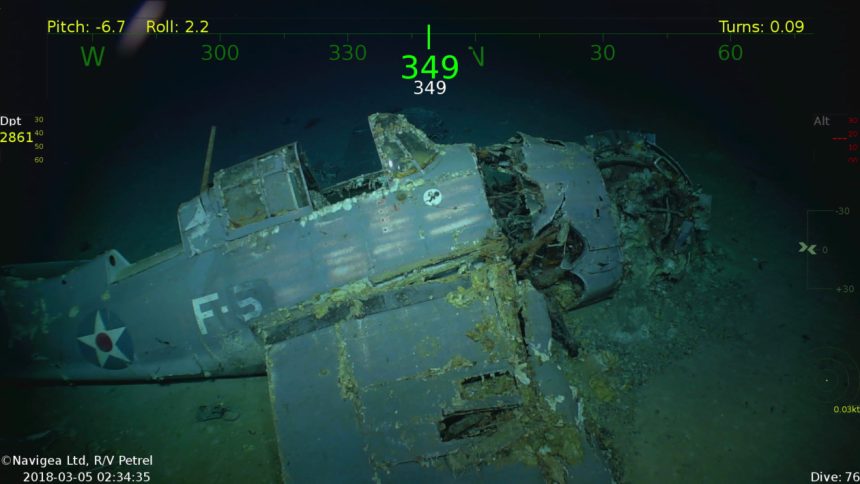How the Remarkable History of the WWII Aircraft Carrier USS Lexington Continues.
Silence, darkness and cold. Those were the only things surrounding the U.S. Navy aircraft carrier USS Lexington (CV-2) since she plummeted to her deep-sea grave on the sea floor two miles below the surface of the war-torn Pacific on May 8, 1942.
Until this week.
Like an improbable plot from one of Clive Cussler’s “NUMA Files” adventure novels, billionaire explorer Paul Allen and his own private fleet of deep-sea scientists used a remotely piloted submarine to discover the wreckage of the USS Lexington on Mar. 4, 2018. She lies on the bottom in 10,000 feet of water about 500 miles off the eastern coast of Australia where she sank. Photos show her deck guns still trained at a black liquid sky waiting for phantom Japanese Zeros, Val dive bombers and Kate torpedo bombers that disappeared into antiquity decades ago.
The USS Lexington’s wreck was discovered from Paul Allen’s private research vessel, the R/V Petrel, on Sunday morning at about 8:00 am local time in the Pacific. Brilliant color images of the Lexington and some of her aircraft were transmitted to the surface and shared around the world over the last 24 hours.
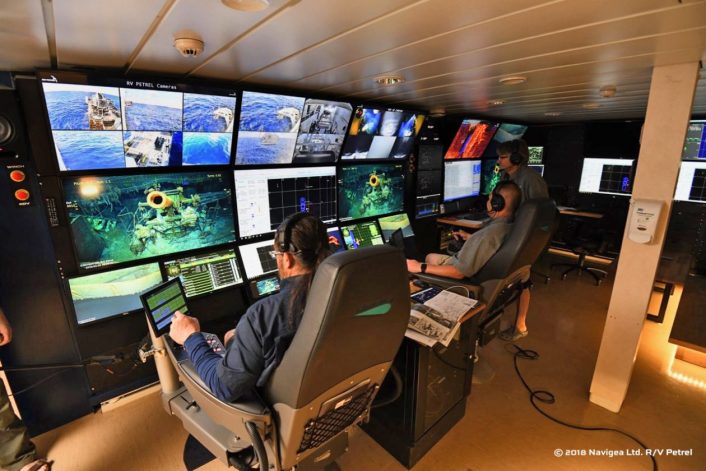
One of the most remarkable photos shows a beautiful, colorful Grumman F4F Wildcat fighter from U.S. Navy Fighter Squadron 3 (VF-3) that was aboard the USS Lexington at Coral Sea. The aircraft wears the “Felix the Cat holding a bomb” insignia common along with four Japanese kill markings on the right side of its fuselage below the canopy. The aircraft sits with its canopy open and its beautiful blue upper wing and fuselage and gray lower surface paint livery. It is the first time anyone has seen the aircraft since she was sent to the bottom in 1942. Despite the crushing depth, corrosive seawater and decades gone by, it remains in amazingly good condition.
Researcher Robert Kraft, director of subsea operations for Allen, was quoted earlier today on Geekwire.com in a story by writer Kurt Schlosser as saying that the USS Lexington was on a priority list of ships to locate by Allen’s team.
“Based on geography, time of year and other factors, I work together with Paul Allen to determine what missions to pursue,” Kraft said. “We’ve been planning to locate the Lexington for about six months and it came together nicely.”
Underwater images and video taken by the remotely operated submersible launched from the research vessel R/V Petrel also show large deck guns on the carrier along with aircraft like the F4F Wildcat and others. The advanced submersible robot camera vehicles used by Allen’s team can submerge to a depth of nearly 20,000 feet and transmit high-resolution video and navigation data to the surface.
Allen’s team also found the fabled USS Indianapolis last year. The cruiser Indianapolis was sunk by a Japanese submarine after a secret mission to deliver the first atomic bomb in 1945. The terrifying ordeal of the Indianapolis survivors became famous after it was featured in a monologue by the fictional character “Quint” in the Peter Benchley novel and movie, “Jaws”.
In 2015 Paul Allen’s team also located the wreck of the Japanese mega-battleship, “Mushashi”, sister ship to the giant Yamato battleship. Mushashi and Yamato remain the largest battleships ever constructed. Both were sunk in WWII.
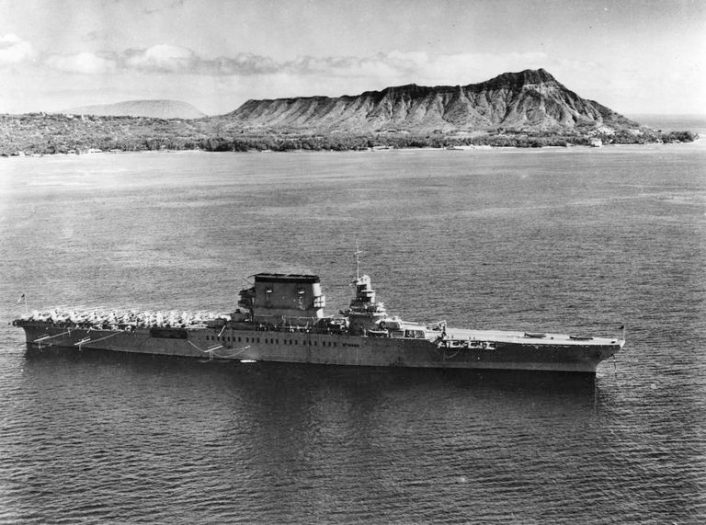
Significant history also surrounds the discovery of the USS Lexington making Allen’s find even more extraordinary.
The USS Lexington was the first full-sized fleet aircraft carrier to be sunk by aircraft launched from an enemy aircraft carrier in WWII. The Lexington took hits from several torpedoes and bombs launched from Japanese aircraft as it fought alongside the USS Yorktown with an opposing force of three Japanese carriers. Her deployment in the region was a critical strategic deterrent to an anticipated Japanese invasion of the Australian mainland that never came. About a year earlier the smaller Royal Navy HMS Hermes, one of the first purpose-built aircraft carriers, was sunk by Japanese dive bombers.
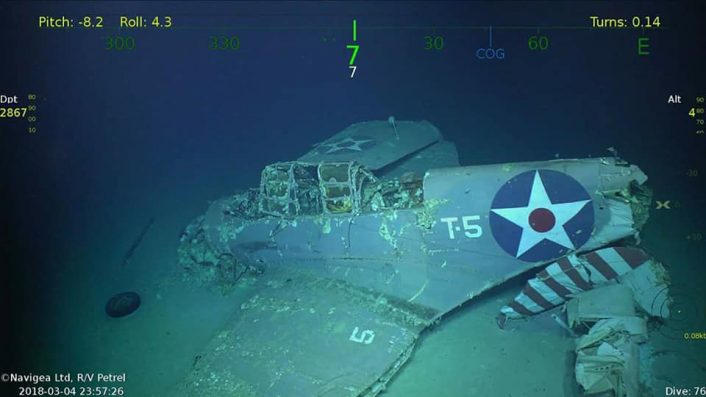
After the USS Lexington took multiple hits from Japanese aircraft on May 8, 1942, a massive explosion tore through her spaces at 12:47 PM. Gasoline vapor from the ruptured port aviation fuel tanks exploded. The giant explosion destroyed the ship’s main damage control station, but air operations continued despite the fires. Remarkably, all of the surviving aircraft from the morning’s strike were recovered by 2:14 PM.
Moments later at 2:42 PM another major explosion tore through the forward part of the Lexington, igniting fires below the flight deck on the hanger deck and leading to a power failure. Though assisted by three destroyers, the Lexington’s damage control parties were overwhelmed after a third explosion ripped through her hull at 3:25 PM. That explosion, the death blow to Lexington, cut off water pressure to the hanger deck preventing fire crews from containing the fire there. As a result, a final, enormous explosion from fuel and ammunition stored in her hold and magazines ignited an uncontrollable inferno on board.
Shortly after 3:28 PM her commander, Captain Frederick Sherman, issued the order to abandon ship. Despite multiple explosions and fires on board Lexington a remarkable 2,770 crewmen and officers were rescued. Tragically, 216 were killed in the Japanese attack on the ship and in the fire-fighting efforts that followed. The USS Lexington was scuttled (purposely sunk) by several torpedoes fired from the USS Phelps to prevent her hulk from falling into Japanese hands.
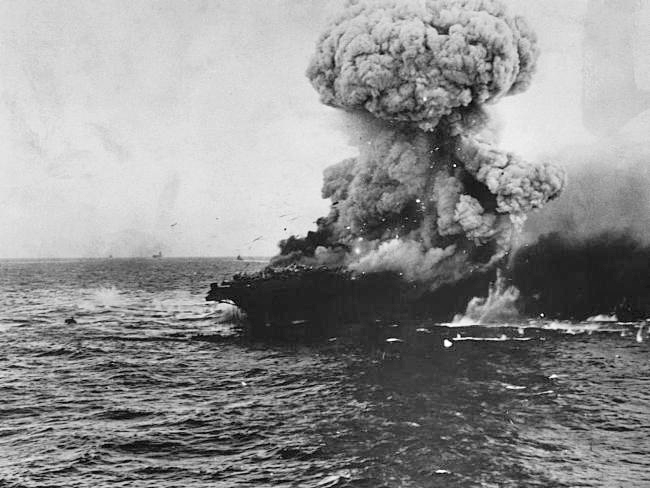
The discovery of the USS Lexington’s wreck and the images made by Paul Allen’s research team provide a unique and invaluable insight into WWII history. This treasure of historical data would have likely remained lost forever if it weren’t for the wealthy investor’s remarkable drive for discovery and commitment to research.
Top image: A Grumman F4F Wildcat sits on the ocean floor in the wreckage of the USS Lexington. (Photo: Vulcan Photo)

